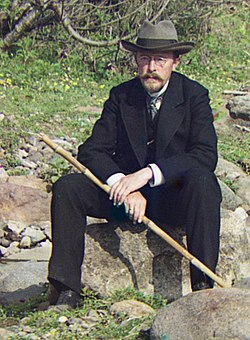Sergey Prokudin-Gorsky

Sergei Mikhailovich Prokudin-Gorskii (August 31, 1863, Murom – September 27, 1944, Paris) (Russian: Сергей Михайлович Прокудин-Горский ) devoted his career to the advancement of photography. Prokudin-Gorskii was born in Murom in Vladimir Oblast, Russia and educated as a chemist.[1] He studied with renowned scientists in Saint Petersburg, Berlin, and Paris, and developed early techniques for taking color photographs.
Technique
His own original research yielded patents for producing color film slides and for projecting color motion pictures. Around 1905 Prokudin-Gorskii envisioned and formulated a plan to use the emerging technological advancements that had been made in color photography to systematically document the Russian Empire. Through such an ambitious project, his ultimate goal was to educate the schoolchildren of Russia with his "optical color projections" of the vast and diverse history, culture, and modernization of the empire.
His process used a camera that took a series of monochrome pictures in rapid sequence, each through a different coloured filter. By projecting all three monochrome pictures using correctly-coloured light, it was possible to reconstruct the original colour scene. He also successfully experimented with making color prints of the photographs, but the process was complicated and slow. Any stray movement within the camera's field of view showed up in the prints as multiple "ghosted" images, since the red, green and blue images were taken of the subject at slightly different times. It was only with the advent of digital image processing that the images could be satisfactorily combined into one.
Photography
Outfitted with a specially equipped railroad car darkroom provided by Tsar Nicholas II, and in possession of two permits that granted him access to restricted areas and cooperation from the empire's bureaucracy, Prokudin-Gorskii documented the Russian Empire around 1909 through 1915. He conducted many illustrated lectures of his work. Prokudin-Gorskii left Russia in 1918, after the Russian Revolution, and eventually settled in Paris, where he died in 1944.
His photographs offer a vivid portrait of a lost world — the Russian Empire on the eve of World War I and the coming Russian revolution. His subjects ranged from the medieval churches and monasteries of old Russia, to the railroads and factories of an emerging industrial power, to the daily life and work of Russia's diverse population.

Prokudin-Gorskii left Russia in 1918, going first to Norway and England before settling in France. By then, the tsar and his family had been executed during the Russian Revolution, and the Communist rule had been established over what was once the Russian Empire. His unique images of Russia on the eve of the revolution — recorded on glass plates — were purchased by the United States' Library of Congress in 1948 from his heirs.[1]
In 2001, the Library of Congress produced an exhibition, The Empire that was Russia. For this exhibition, the glass plates were scanned and color images were produced digitally from the scanned red, green, and blue monochrome images, using a process called Digichromatography which was developed by Walter Frankhauser.
In 2004, the Library contracted with Blaise Agüera y Arcas to produce an automated color composite of each of the 1,902 negatives from the high resolution digital images of the glass plate negatives. A complete description of his process and a list of other sites that have prepared digital color composite images are in the collection profile at the Library of Congress.[2][3]
Gallery
-
Interior of Cathedral of the Assumption, Smolensk
-
Factory interior with electrical generators
References
- ^ a b Photographer to the Tsar: Sergei Mikhailovich Prokudin-Gorskii Library of Congress. Retrieved 13 August 2006
- ^ Reconstructing Prokudin-Gorskii's Color Photography in Software Blaise Agüera y Arcas. Retrieved 13 August 2006.
- ^ About the Prokudin-Gorskii Collection Retrieved 13 August 2006.
External links
- Collection Profile at the Library of Congress
- Library of Congress exhibit, The Empire that was Russia (selection of items)
- Search page to access all Prokudin-Gorskii items at the Library of Congress
- Prokudin-Gorskii images presented by the Library of Congress' English-Russian project Meeting of Frontiers
- Russian page with many Prokudin-Gorskii related links
- Russian database with all the Prokudin-Gorskii photos, including those not yet restored
- Private Prokudin-Gorskii project by Frank Dellaert
- Another privately compiled Prokudin-Gorskii gallery
- Prokudin-Gorskii's pictures of Tolstoy - on the University of Toronto's Tolstoy Studies site
- On-line exhibit of Prokudin-Gorskii at Šechtl and Voseček Museum of Photography
- Prokudin-Gorskii: 1910 vs 2003. Comparison of some places


